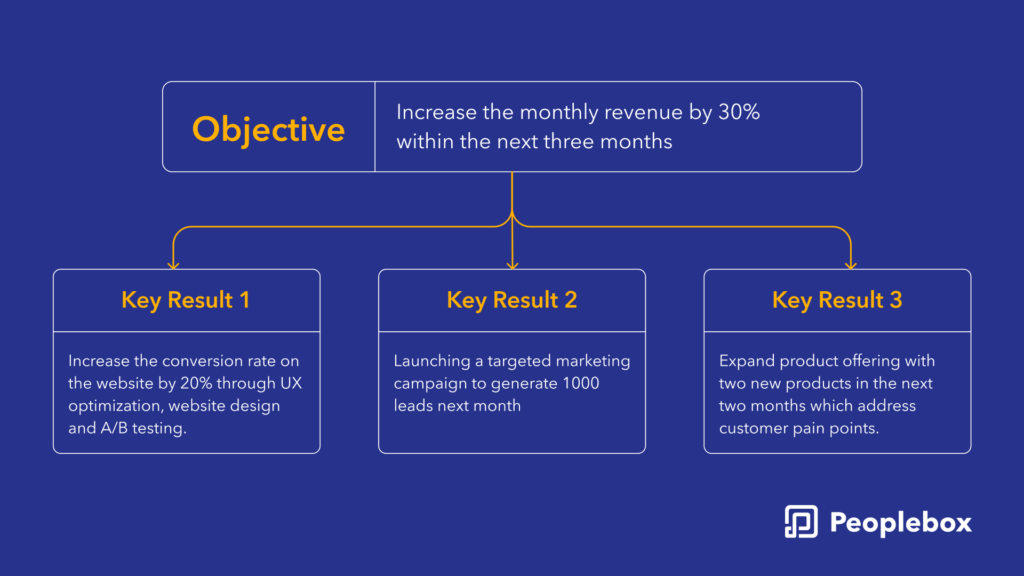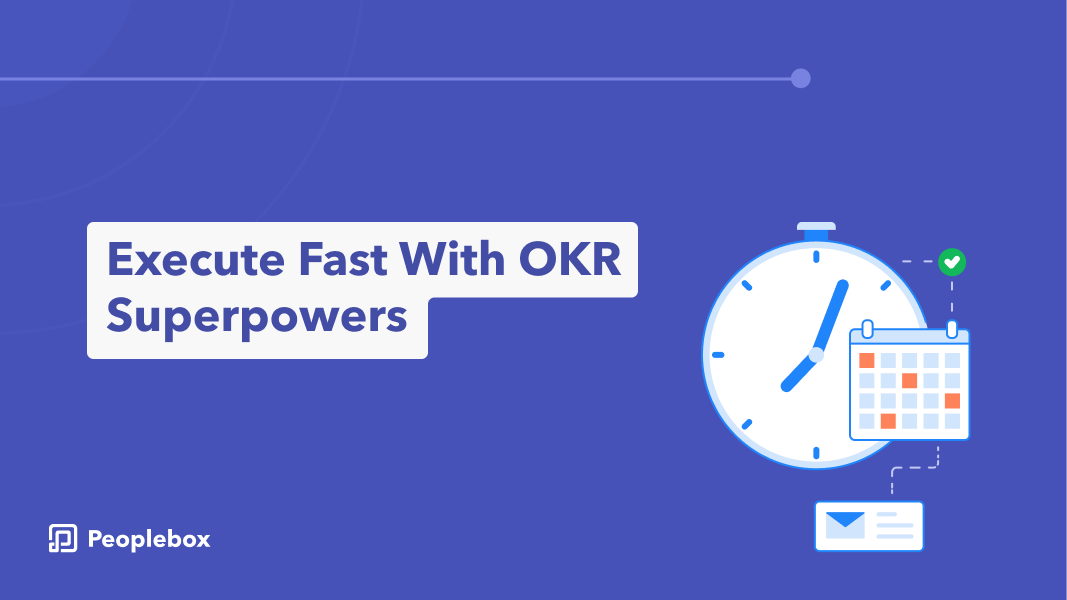Did you know?
During the financial crisis in 2008-2009, Google used the OKR framework to manage costs and prioritize projects. In 2009, Google reported revenue of $23.65 billion, an increase of 8.5%.
In times of crisis, such as economic downturn, businesses struggle to achieve their targets. They struggle to manage their finances, supply chain, and workforce effectively. They face significant pressure to adapt quickly to changing circumstances.
To sail through a crisis businesses need to be agile. They need to understand their situation and develop contingency plans to manage risks. They also need to communicate effectively with their employees, customers, and stakeholders. They should quickly adapt their operations and strategies as needed.
OKR provides a clear and structured approach to managing business priorities. It helps businesses rapidly adapt strategies, processes, and goals to remain competitive and sustainable.
It gives businesses the superpower to focus on what’s most important. In this blog, we will talk about the OKR superpowers that every business must harness.
OKR in a Nutshell
OKR stands for Objectives and Key Results. It is a framework that helps organizations set and achieve their goals. An Objective is a clear and specific goal an organization wants to achieve. Key Results are specific, measurable outcomes used to track progress towards the Objective.
In the OKR system, there should be three objectives, with each having 3-5 Key Results. These key results help measure progress towards achieving the objective. OKRs are set for a quarter, and tracking happens regularly.
It encourages focus, alignment, and transparency in the organization’s strategies. It promotes a culture of continuous improvement.
What Are OKR Superpowers?
At the heart of the OKR methodology are five “superpowers”. These help teams align their efforts, focus on priorities, and achieve moonshot goals. By harnessing these superpowers, companies like Google have achieved their goals during crises. They achieved better results and built a culture of continuous improvement and learning.
1. Focus and commit to the priorities
OKRs help organizations to focus on their priorities and commit to achieving them. The OKR framework requires setting clear, specific, and measurable objectives and key results.
By setting specific objectives and identifying key results, employees prioritize their efforts. They focus on the most important tasks and activities. This minimizes distractions and helps them avoid spending resources across several goals. Which otherwise can lead to a lack of progress in any or one area.
Setting objectives and publicly sharing them creates a sense of accountability and ownership. The employees and teams feel motivated to work towards achieving their goals.
2. Align and connect for teamwork
The superpower of OKR promoting teamwork lies in its ability to align individual and organizational goals. They also help in cross-functional collaboration and promote transparency and accountability.
OKR help to align and connect teams towards a common purpose. It promotes teamwork and collaboration within an organization. By doing so, OKRs help create a culture of teamwork and shared purpose.
Aligning individual objectives with the organization’s overall goals, OKRs also facilitate cross-functional collaboration. By setting objectives dependent on the contributions of multiple teams, OKRs help break down silos. This encourages communication and collaboration across different departments.
3. Track for accountability
Another superpower of OKRs is tracking progress towards goals. Setting OKRs involves identifying specific, measurable, and time-bound key results. When something is measurable, tracking progress towards achieving that objective becomes easy.
This specificity and measurement provide a way to assess progress and success. This promotes accountability at both individual and team levels.
OKRs are set and reviewed weekly, monthly & quarterly which helps in assessing progress and adjusting KRs. This regular review helps to ensure that everyone is aware of their progress. That they identify areas where they may need to refocus their efforts.
4. Stretch for amazing results
OKRs help organizations to stretch beyond their current capabilities and achieve results. The key feature of an OKR that allows for this stretch is setting ambitious objectives or moonshot goals.
The objectives should be challenging but achievable. It should motivate individuals and teams to push themselves beyond their comfort zone and strive for excellence.
When you set ambitious objectives, employees and teams think creatively. They identify new-innovative ways to achieve those goals. This leads to breakthrough thinking and results that might not have been possible with less ambitious targets.
The key results of an OKR can also contribute to this stretch. It challenges individuals and teams to work harder. It forces them to be more creative in order to achieve the desired outcomes.
Example:

5. Continuous performance management
Traditional performance management processes often rely on annual or semi-annual reviews. Which can be infrequent, time-consuming, and demotivating for employees.
In contrast, OKRs provide a framework for regular check-ins and progress reviews. Which supports ongoing performance management and improvement.
The OKR process involves ongoing reviewing of progress. This ongoing review allows for continuous feedback and course correction. It helps teams to stay on track and adjust their strategies as needed.
Regular check-ins also allow for frequent communication between managers and employees.
Additionally, the continuous performance management aspect of OKR supports employee engagement and motivation.
Did you know that 95% of employees do not understand or are unaware of the company strategy? This obviously results in poor communication and implementation of strategies.
When employees understand company goals and strategies, they are more likely to feel engaged and motivated in their work. They will be able to achieve performance breakthroughs. OKRs allow employees to have more ownership and control over their work. They understand better how their work contributes to the larger company goal.
OKR Software - Rated 4.8 on G2
Empower your managers to be a better leader with essential performance tools & personalized coaching support.
How Do These Superpowers Help Businesses Execute Faster?
1. Enabling founders to delegate and focus on business growth
As a company grows, the founder’s role often shifts from being hands-on in all aspects of the business. They move on to delegating tasks and responsibilities to other team members. OKRs can help to facilitate this shift by providing a clear and structured framework for setting goals and tracking progress.
With OKRs, the founder can set high-level objectives for the company. They can then work with the team to break these objectives into specific, measurable key results. The founder can assign key results to different teams or departments. This allows the founder to focus on driving business growth.
2. Enabling teams to be predictive of future
OKRs enable teams to predict the future by encouraging a forward-looking mindset. It helps to focus on outcomes rather than activities.
When teams set OKRs, they identify specific, measurable key results demonstrating progress. The teams have to think about what outcomes they want to achieve, and how they will know they are successful.
By setting measurable key results, the team sets up a predictive model for success. If they are able to achieve all the key results, they succeed in achieving that objective. This success helps them to predict future success rates.
3. Help you turn failure into data
In the OKR, key results are measurable and trackable metrics. If a team fails to achieve a key result, they can use the data to identify why they fell short. They can make changes to improve performance in future.
This approach to failure is popular as a “fail forward” or “learn fast” mentality. By viewing failures as learning opportunities, teams gather data on what did not work. They can make adjustments to improve their future performance.
This data-driven approach to problem-solving is valuable for startups and small businesses. Because like larger companies, they don’t have the resources to experiment and iterate.
The team can analyze the data from a key result, when not achieved, and ask questions like:
- Why did we fall short?
- Were our assumptions about the goal or our approach incorrect?
- Did we set the right key results or were they too ambitious or not ambitious enough?
- What did we learn from this experience and how can we apply this to future goals?
4. Creates a culture of saying NO to unworthy projects
OKR helps focus on the most important objectives and key results. This means that the company will have to say no to projects or initiatives not aligned with its goals.
When setting OKRs, teams identify 2-3 key objectives most important to the business. By focusing on a small number of objectives and key results, teams make difficult choices. They decide which project is a high priority and which is not.
This helps create a culture of saying no to unworthy projects.
For example, a team may set an objective to increase sales revenue by 20% in the next quarter. To achieve this, they might set key results that measure metrics like the number of new customers acquired. Or the percentage increase in sales from existing customers. If a potential new project does not align with this objective or key results the team should not work on it. They must focus their efforts on initiatives that help them achieve their goal.
How Combining OKRs With Project Management Sets You up for Success
Takeaways
Implementing OKR provides a clear focus on achieving specific and measurable goals. Teams stay motivated and focused on priorities. To help companies achieve this a tool like Peoplebox serves as a powerful enabler.
By providing a centralized platform for setting, tracking, and monitoring, a tool streamlines the OKR process. It facilitates communication and collaboration, enabling teams to work together more efficiently. It provides real-time visibility into progress. It helps managers to track progress and identify potential roadblocks.
An OKR tool can be an effective way to speed up OKR execution and achieve better results. To get a glimpse of the effectiveness of an OKR tool, book your demo with Peoplebox today!








